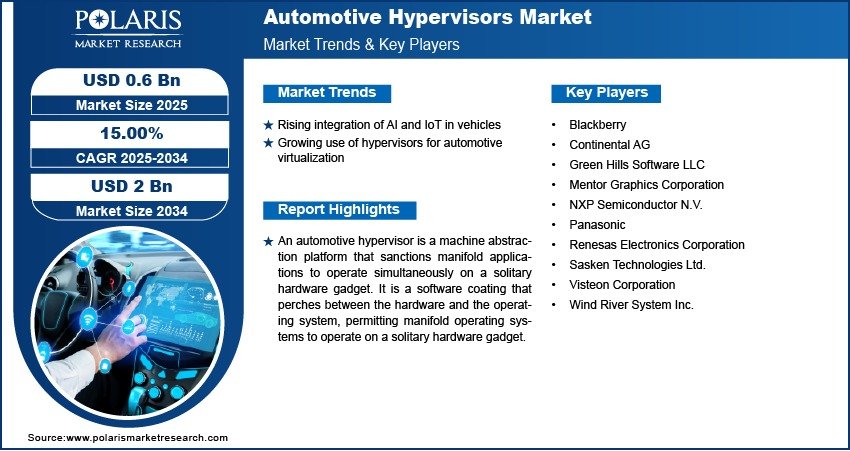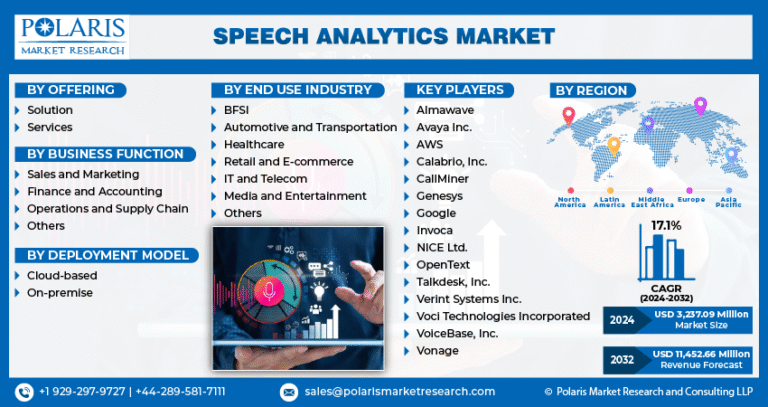Automotive Hypervisors Market Forecast to Reach USD 2 Billion by 2034 | Growing at a CAGR of 15.00%

The global Automotive Hypervisors Market was valued at USD 0.5 billion in 2024 and is projected to reach significant heights by 2034, growing at a CAGR of 15.00% during the forecast period. As the automotive industry shifts toward more connected, autonomous, and software-defined vehicles, hypervisors are becoming crucial to managing multiple operating systems within a single hardware unit. These virtualization platforms are revolutionizing vehicle electronics architecture, enabling safe and efficient functioning of infotainment, ADAS, and other electronic control units.
Market Overview
Automotive hypervisors allow multiple systems to run independently on a single hardware platform, improving safety, scalability, and cost-effectiveness. In modern vehicles, where infotainment systems, instrument clusters, and autonomous systems need to operate simultaneously without interference, hypervisors enable seamless functionality through virtualization. This market is witnessing strong momentum due to increasing investments in electric and autonomous vehicles, alongside the growing adoption of domain and zonal architecture in automotive electronics.
Key Market Trends
- Shift Toward Software-Defined Vehicles (SDVs): OEMs are embracing SDVs that rely heavily on centralized computing and virtualization, spurring demand for automotive hypervisors.
- Rising Adoption of Infotainment and Digital Cockpit Systems: Multi-display infotainment systems that run on Android Auto, Apple CarPlay, and other platforms benefit greatly from hypervisor technology.
- ADAS and Autonomous Driving Integration: Hypervisors help run safety-critical and non-safety-critical applications on the same hardware, supporting advanced driver-assistance systems.
- Growth of Connected Cars: With rising connectivity features in vehicles, hypervisors are used to separate external network functions from critical vehicle control systems, ensuring cybersecurity.
Market Size & Forecast:
- Market size value in 2024 – USD 0.5 billion
- Revenue forecast in 2034 – USD 2 Billion
- CAGR – 15.0% from 2025 – 2034
Key Growth Drivers
- Increasing Electronic Complexity in Vehicles: With growing electronic content per vehicle, there is a need for more efficient management of ECUs, which hypervisors facilitate.
- Demand for Vehicle Safety and Consolidation of ECUs: Hypervisors allow consolidation of multiple ECUs into fewer, more powerful processors, reducing hardware costs while improving reliability.
- Regulatory Push Toward Automotive Safety Standards (e.g., ISO 26262): Hypervisors support the separation of safety-critical and non-safety-critical applications, aligning with global functional safety standards.
- Growth in Electric and Autonomous Vehicles: As EVs and AVs rely heavily on software for operation, hypervisors play a central role in virtualization and efficient system management.
𝐆𝐞𝐭 𝐄𝐱𝐜𝐥𝐮𝐬𝐢𝐯𝐞 𝐒𝐚𝐦𝐩𝐥𝐞 𝐏𝐚𝐠𝐞𝐬 𝐨𝐟 𝐓𝐡𝐢𝐬 𝐑𝐞𝐩𝐨𝐫𝐭:
https://www.polarismarketresearch.com/industry-analysis/automotive-hypervisors-market/request-for-sample
Challenges
- Complexity in Integration and High Cost: Integrating hypervisors into automotive platforms can be technically complex and expensive for manufacturers.
- Need for Real-Time Performance: Automotive systems require real-time response, and managing multiple virtual machines without performance lag is a significant technical hurdle.
- Cybersecurity Concerns: While hypervisors enhance isolation, they can become a single point of failure if not secured properly, requiring robust software security mechanisms.
Opportunities
- Zonal Architecture and Centralized Computing Platforms: Transitioning from distributed to centralized vehicle architectures creates long-term opportunities for hypervisor solutions.
- Emergence of AI-Driven Vehicle Functions: Hypervisors will play a role in managing AI-based applications across infotainment, driver monitoring, and autonomous decision-making.
- Growth in Shared Mobility and Fleet Applications: Fleet management platforms benefit from hypervisor-based systems that support remote diagnostics and over-the-air (OTA) updates.
Conclusion
The global Automotive Hypervisors Market is positioned for significant growth due to increasing demand for intelligent, connected, and autonomous vehicles. Hypervisors serve as the backbone of modern in-car software infrastructure, enabling efficient hardware usage, enhanced safety, and seamless integration of multiple applications. As OEMs continue to invest in next-gen vehicle platforms, the role of hypervisors in achieving safety, performance, and cost goals will only become more central.






